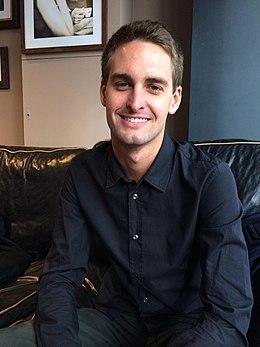
Snap Maker - Evan Spiegel
Content
He had rich parents. Therefore, his career is not built according to the scheme "from rags to riches and to a millionaire." Perhaps it was the wealth and luxury in which he grew up that influenced his business decisions, when he easily and without much hesitation or dilemma rejected billions of offers.
CV: Evan Thomas Spiegel
Date and place of birth: 4th of June 1990
Los Angeles, USA)
Address: Brentwood, Los Angeles (USA)
Citizenship: American
Family status: Free
Luck: $6,2 billion (as of March 2017)
Contact person: [email is protected]
Education: Crossroads School for Arts and Sciences (Santa Monica, USA); Stanford University (USA)
An experience: founder and CEO of Snap Inc. – company owner of the Snapchat app
Interests: books, fast
cars
He was born on June 4, 1990 in Los Angeles. His parents, both reputable lawyers, provided him with a carefree childhood in luxury and an excellent education. He studied at the famous Crossroads School for Arts and Sciences in Santa Monica, and then entered one of the best universities in the world - Stanford University. However, like Bill Gates and Mark Zuckerberg, he dropped out of his prestigious studies without hesitation when he and his colleagues came up with an unusual idea...
Seniors don't understand
That idea was Snapchat. The app, developed by Evan and his colleagues (under the company of the same name, founded in 2011 and renamed Snap Inc. in 2016), quickly became a hit around the world. In 2012, its users sent an average of 20 million messages (snaps) per day. A year later, this number tripled and in 2014 reached 700 million. In January 2016, users sent an average of 7 billion snaps daily! The tempo falls to its knees, although it must be admitted that it is no longer so stunning. Many find it difficult to understand the phenomenon of Snapchat's popularity - applications for sending photos that after 10 seconds ... disappear. The Stanford faculty also didn't "get" the idea, and neither did many of Evan's colleagues. He and other app enthusiasts explained that the essence of the idea is to make users realize the value of communication. Volatility. Spiegel has created a tool that allows you to see what's going on with a friend when we wake up in the morning, or share some funny moment with a friend in the form of a short video that is about to disappear because it really isn't. worth saving. The key to Snapchat's success was changing the schema. In general, instant messaging sites and social networks were previously based on text communication. Spiegel and the company's co-founders decided that their app, originally called Picaboo, would be driven by images rather than words. According to stalwarts, Snapchat is restoring the privacy and security that the web has lost — that is, what social networking sites were originally built on, before the creators of Facebook and Twitter succumbed to the temptation to create a new Google and began to acquire users. at any price. You can see the difference if you compare the average number of friends on a particular site. On Facebook it's a group of 150-200 close and distant friends, and we share pictures with a group of 20-30 friends.
Zuckerberg hit the trash
As for who the real creator of Snapchat is, there are different versions. The most official one says that the idea for the application was submitted by Spiegel as a project as part of his research. Bobby Murphy and Reggie Brown helped him build the first version of the app.
Evan Spiegel and Mark Zuckerberg
According to another version, the idea was born during a fraternal party, and its author was not Evan, but Brown. He reportedly asked for a 30% stake, but Evan did not agree. Brown overheard a conversation with his colleague that Evan was planning to fire him from the company. When Spiegel asked him to patent Snapchat, Brown decided to use the situation to his advantage by signing first everywhere as the most important investor. Shortly thereafter, Evan disconnected him from information from the company, changing passwords to all sites, servers and breaking the connection. Brown then lowered his demands and said he would be fine with a 20% stake. But Spiegel got rid of him completely, without giving him anything.
Mark Zuckerberg, who founded Facebook a few years earlier under similar circumstances, tried several times to buy out Snapchat. In the beginning, he offered a billion dollars. Spiegel refused. He was not seduced by another proposal - 3 billion. Some hit their heads, but Evan didn't need the money. After all, unlike Zuckerberg, he was “home rich.” However, the company's new investors, including Sequoia Capital, General Atlantic and Fidelity, agreed with the creator of Snapchat, and not with Zuckerberg, who clearly underestimated him.
Throughout 2014, other managers with experience in. However, the most important reinforcement was the employment of Imran Khan in December 2014. The banker who has listed giants such as Weibo and Alibaba (the biggest debut in history) is the director of strategy at Snapchat. And it is Khan who is behind the investment in Evan, the Chinese e-commerce mogul Alibaba, who bought the shares for $200 million, pushing the company's value to $15 billion. There is no escape from advertising, but the first ad appeared on Snapchat only on October 19, 2014. It was a specially prepared 20-second trailer for Ouija. Evan assured that the ads in his app will provide information in a fun and interesting way. In 2015, he toured the biggest ad agencies and big clients, explaining the potential of being on Snapchat. The lure is access to young people aged 14-24 who are closely connected to the app and spend an average of 25 minutes a day on it. This is a great value for the company, because this group is very attractive, although it easily eludes most advertisers.
Three quarters of mobile traffic comes from Snapchat
In the US, Snapchat is used by 60% of smartphone owners aged 13 to 34. What's more, 65% of all users are active - they post photos and videos every day, and the total number of videos viewed exceeds two billion a day, which is half of what Facebook has. About a dozen months ago, data from the British mobile operator Vodafone appeared on the network, according to which Snapchat is responsible for three-quarters of the data sent in all communication applications, including Facebook, Whatsapp, etc.
Snap Inc. Headquarters
The ambitions of the head of Snap Inc. for some time has been about proving that Snapchat can be a serious medium. This was the goal of the Discover project launched in 2015, which is a website with short video reports provided by CNN, BuzzFeed, ESPN or Vice. As a result, Snapchat received more recognition in the eyes of potential advertisers, which helped in the conclusion of the first contracts. In any case, the display of companies on Snapchat can hardly be called a typical advertisement - it is rather a dialogue between the brand and a potential client, interaction, drawing them into the world of the manufacturer. At the moment, Snapchat is mainly used in the telecommunications and food industries, which care about the first users, that is, users who are the first to explore new platforms and set trends.
Spiegel founded Snap Inc. located near Muscle Beach in Los Angeles, which became famous in the 70s, incl. by Arnold Schwarzenegger. The company's headquarters is a two-story loft, one of dozens of buildings rented by companies in Venice, Los Angeles County. The area along the ocean road has many skate parks and small shops. On the walls of the building you can see large murals with portraits of celebrities by a local artist hiding under the pseudonym ThankYouX.
Stock market test
In 2016, the growth of new users slowed down significantly, and investors began to demand from Evan's company listing on the stock exchange. To do this, the company hired Goldman Sachs and Morgan Stanley. The plan was to go public in March 2017 to catch the American boom. Investors were concerned that Snap Inc. did not share the fate of Twitter, which failed to build a sustainable money-making model and lost 2013 billion dollars in its market capitalization since its debut in November 19. (58%). The debut, which, as planned, took place on March 2, 2017, was very successful. The price at which the company sold 200 million shares before going public was only $17. That means over $8 in earnings per share. Snap Inc. raised $3,4 billion from investors.
The New York Stock Exchange on the launch day of Snap Inc.
Snapchat has risen to the top of the league and aims to compete with the biggest sites of its type such as Facebook and Instagram. The latest statistics show that Mark Zuckerberg's website has almost 1,3 billion daily users, and Instagram has 400 million users, eight and more than twice as many as Snapchat, respectively. Snap Inc. He is not yet making money from this business - over the past two years, the business has lost almost a billion dollars in net losses. Even in the stock prospectus Spiegel, or rather, his analysts directly wrote: "The company may never become profitable".
The fun is over and shareholders will soon be asking about earnings. How will 27-year-old Evan Spiegel fulfill his role as head of a large public company with shareholders, a board of directors, pressure on earnings and dividends, etc.? We'll probably find out soon.

